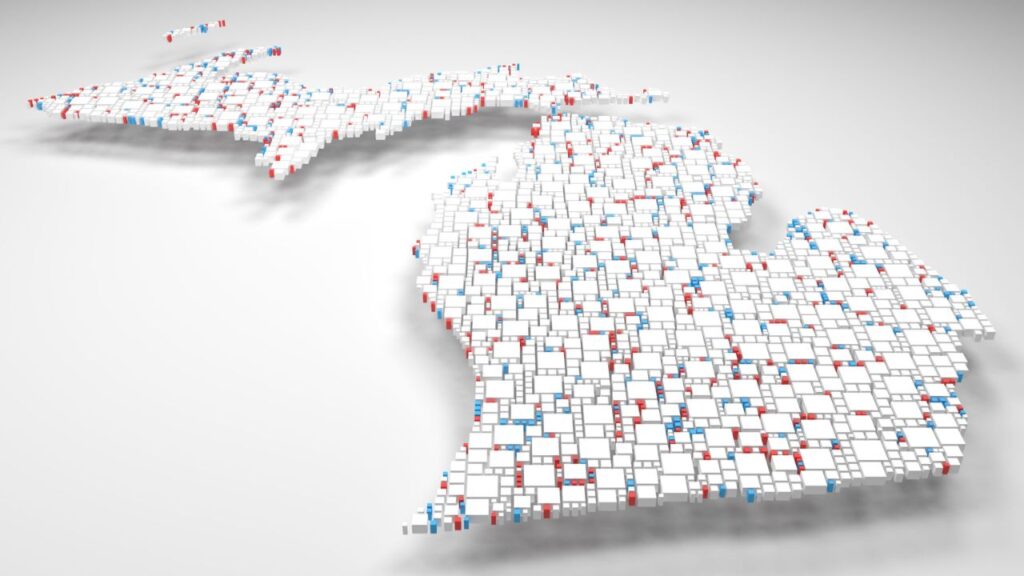In a stunning decision, a panel of three federal judges ruled on December 21, 2023, that 13 of Michigan’s House and Senate districts, all currently held by Democrats, were drawn in violation of the Voting Rights Act (VRA) and the Equal Protection Clause of the U.S. Constitution. The judges ordered the districts to be redrawn before the 2024 election, which could have major implications for the balance of power in the state legislature and the congressional delegation.
The lawsuit, Agee v. Benson, was filed by 19 African-American Detroiters who live in the affected districts, and claimed that the Michigan Independent Citizens Redistricting Commission (MICRC), which was created by a 2018 constitutional amendment and drew the maps in 2021, diluted the voting power of Black voters by splitting them into districts with large white majorities. The plaintiffs argued that the MICRC violated Section 2 of the VRA, which requires that minority groups have an equal opportunity to elect their preferred candidates.
The judges agreed with the plaintiffs, and found that the MICRC drew the districts predominantly on the basis of race, without a compelling state interest or a narrow tailoring of the means to achieve that interest. The judges also rejected the MICRC’s defense that it followed the constitutional criteria and the public input in drawing the maps, and that it did not intend to discriminate against Black voters.
The Impact of the Ruling
The ruling is a bombshell for Michigan politics, as it could potentially change the outcome of the 2024 election and beyond. The 13 districts that need to be redrawn are:
- House Districts 1, 2, 3, 4, 5, 6, 7, 8, 9, 10, and 11, which cover parts of Detroit, Dearborn, and other suburbs in Wayne County.
- Senate Districts 2 and 3, which cover most of the same areas as the House districts.
According to the 2020 census, Detroit has a population of 639,111, of which 76.3% are Black. However, under the current maps, only four of the 13 districts have a Black voting-age population (BVAP) of more than 50%, and none have a BVAP of more than 60%. The plaintiffs argued that this reduced the ability of Black voters to elect their preferred candidates, especially in primary elections, where they often faced white challengers who had more resources and support from outside groups.
The judges ordered the MICRC to redraw the districts to increase the BVAP to at least 60% in each district, and to ensure that the districts are compact, contiguous, and respect communities of interest. The judges also ordered the MICRC to submit the new maps to the court by February 1, 2024, and to hold at least three public hearings on the proposed maps before submitting them.
The new maps could have a significant impact on the political landscape of Michigan, which is currently divided between a Democratic governor, a Republican-controlled Senate, and a narrowly Democratic-controlled House. The redrawing of the districts could create more competitive races, or even flip some seats from one party to another, depending on how the voters react to the changes. The ruling could also affect the congressional districts, which are based on the state legislative districts, and potentially alter the representation of Michigan in the U.S. House of Representatives.
The Reaction to the Ruling
The ruling has sparked mixed reactions from different stakeholders and observers. The plaintiffs and their supporters hailed the ruling as a victory for voting rights and racial justice, and praised the judges for upholding the VRA and the Constitution. They argued that the ruling would restore the voice and the power of Black voters in Michigan, and ensure that they have a fair representation in the state and federal government.
The MICRC and its supporters, on the other hand, expressed disappointment and frustration with the ruling, and criticized the judges for overturning the will of the people and the work of the commission. They argued that the ruling was based on a flawed interpretation of the law and the facts, and that it undermined the purpose and the legitimacy of the MICRC, which was created to end partisan gerrymandering and to increase public participation and transparency in the redistricting process.
The ruling also drew attention from national media and political analysts, who noted that it was one of the first major challenges to the new independent redistricting commissions that were established in several states after the 2018 midterm elections. The ruling raised questions about the legal and political implications of the commissions, and whether they could withstand the scrutiny and the pressure from the courts and the parties.
Conclusion
The ruling by the federal judges is a bombshell that could have a profound impact on the political future of Michigan and the nation. The ruling requires 13 of Michigan’s House and Senate districts, all currently held by Democrats, to be redrawn before the 2024 election, to increase the voting power of Black voters. The ruling is a victory for the plaintiffs and their advocates, who claimed that the districts were drawn in violation of the Voting Rights Act and the Equal Protection Clause. The ruling is a setback for the MICRC and its supporters, who defended the maps as fair and constitutional. The ruling is also a challenge for the independent redistricting commissions, which face legal and political hurdles in their attempt to reform the redistricting process. The ruling is likely to be appealed, and the final outcome is uncertain. However, the ruling has already sparked a heated debate and a fierce competition over the shape and the fate of Michigan’s political map.

